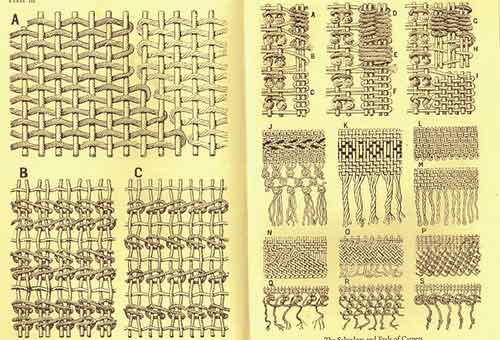
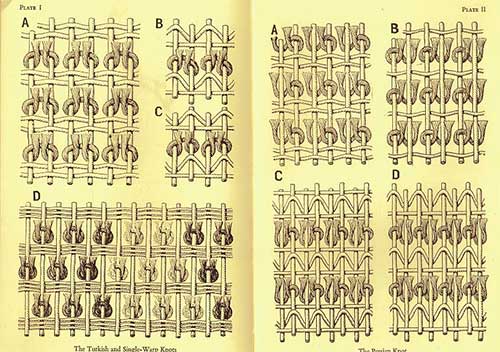
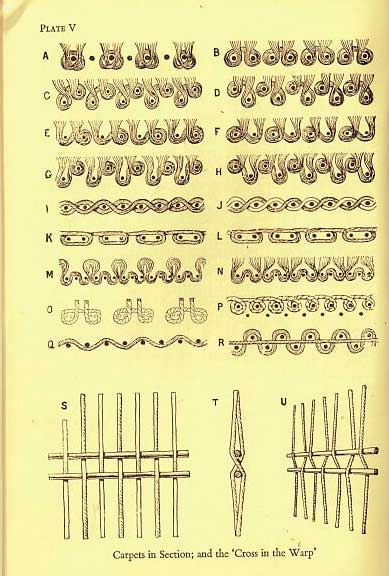
Glossary of Terms
The chart below comes from Brigham Young University Anthropology Dept. website.
This page is intended to be only a brief overview of the more commonly used rug weaving terms.
Plain weave
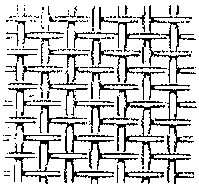 Plain weave is the simplest type of weave. A single weft is progressively passed over one warp and under the next warp, working across the width of the loom. The weft is then passed back through warps in the opposite direction alternating from the previous over-and-under pattern. Variations are possible by using double or tripled warp or weft threads in a variety of combinations.
Plain weave is the simplest type of weave. A single weft is progressively passed over one warp and under the next warp, working across the width of the loom. The weft is then passed back through warps in the opposite direction alternating from the previous over-and-under pattern. Variations are possible by using double or tripled warp or weft threads in a variety of combinations.
Warp-faced weave
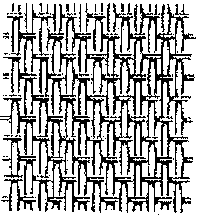 Warp-faced weave fabric has greater number of warp threads per centimeter, while weft-faced weave fabric has a greater number of weft threads per centimeter. When both the warp and weft threads are equal in number per centimeter, it is termed balanced weave. All textiles fall into one of these categories.
Warp-faced weave fabric has greater number of warp threads per centimeter, while weft-faced weave fabric has a greater number of weft threads per centimeter. When both the warp and weft threads are equal in number per centimeter, it is termed balanced weave. All textiles fall into one of these categories.
Brocade
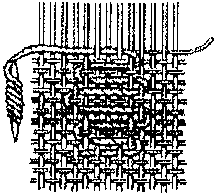 Brocaded textiles use two weft threads in each passage: one to create the foundation fabric or “ground cloth,” the other to create the design. This additional (or supplemental) weft thread used in creating the design is woven at the same time as the ground cloth. The supplemental thread may extend the entire width of the textile or it may cover only a portion of it.
Brocaded textiles use two weft threads in each passage: one to create the foundation fabric or “ground cloth,” the other to create the design. This additional (or supplemental) weft thread used in creating the design is woven at the same time as the ground cloth. The supplemental thread may extend the entire width of the textile or it may cover only a portion of it.
Double cloth (below) is composed of two plain-weave, superimposed layers of fabric that share the same warp or weft. Designs are created as warp or weft threads interchange from one layer of fabric to the other.
Double cloth
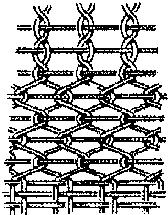 Complimentary weave utilizes warp threads to create the design. A complimentary weave is created by alternating two warp threads of different colors, bringing the desired color to the front, while leaving the other color to create the design on the opposite side. When complete, the same design is seen on both sides of the fabric, only the colors are reversed.
Complimentary weave utilizes warp threads to create the design. A complimentary weave is created by alternating two warp threads of different colors, bringing the desired color to the front, while leaving the other color to create the design on the opposite side. When complete, the same design is seen on both sides of the fabric, only the colors are reversed.
Tapestry
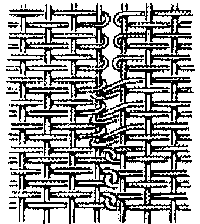 Tapestry is a woven textile in which the wefts of the textile conceal the warps. instead of one weft crossing the entire width of the fabric, however, a number of wefts of different colors are used, each crossing back over any number of warps, as often as needed to create the design. Slit-tapestry and dovetailing are two examples of tapestry.
Tapestry is a woven textile in which the wefts of the textile conceal the warps. instead of one weft crossing the entire width of the fabric, however, a number of wefts of different colors are used, each crossing back over any number of warps, as often as needed to create the design. Slit-tapestry and dovetailing are two examples of tapestry.
Twill weave is similar to plain weave in that the weft passes over and under warp threads. However, warp yarns are skipped at predetermined intervals to create a diagonal rib in the weave.
Twill weave
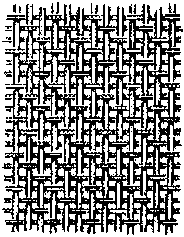 Diamond twill is one type of twill weave. In this technique the diagonal ribs move outward in opposite directions from a central point, forming a “V.” The pattern is then reversed, creating an upside down “V,” resulting in the shape of a diamond. Diamond twill Two-faced or Double weave creates one pattern on one side of the rug, and a different pattern with different colors on the opposite side of the rug. Although all weft colors are being used on both sides, the wefts on one side pass over a greater number of warps than the opposite side and are packed so tightly that the undesirable colors are hidden even though they are being used.
Diamond twill is one type of twill weave. In this technique the diagonal ribs move outward in opposite directions from a central point, forming a “V.” The pattern is then reversed, creating an upside down “V,” resulting in the shape of a diamond. Diamond twill Two-faced or Double weave creates one pattern on one side of the rug, and a different pattern with different colors on the opposite side of the rug. Although all weft colors are being used on both sides, the wefts on one side pass over a greater number of warps than the opposite side and are packed so tightly that the undesirable colors are hidden even though they are being used.
Gauze
Gauze is created as pairs of warps are alternatively crossed over one another and secured in position as the weft thread passes through. Open work and complex gauze are two ways of manipulating warp threads to create additional gauze patterns.
We thank Brigham Young University for this page describing different rug weaving threads.
